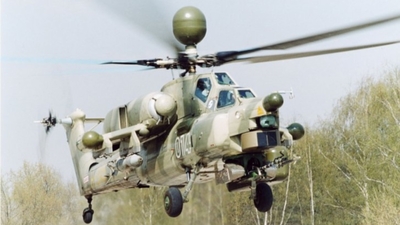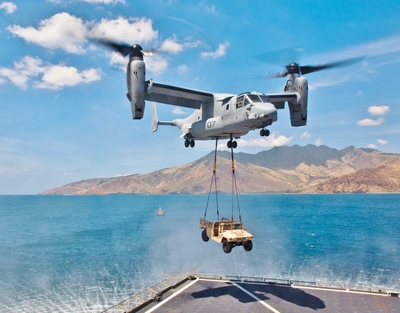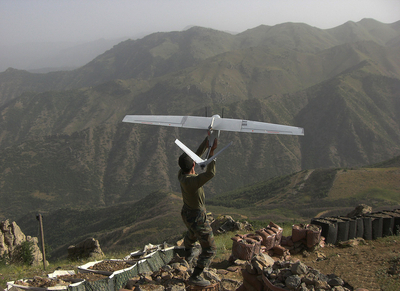War on ISIS
President Obama has authorized an additional 1,500 U.S. troops to be sent to Iraq, doubling the current deployment. The trainers and advisers are heading into Anbar Province to help Iraqis and Kurds as they plan a major offensive expected next spring against ISIS fighters. Nearly three months into the largely aerial operation, the President admitted it was too early to say if the U.S.-led effort was succeeding.
While Allied military contributions to the anti-ISIS coalition have been fairly meager, Singapore announced it was sending a Boeing KC-135R Stratotanker for air-to-air refueling while Norway announced it would send 120 soldiers to help train Kurdish and Iraqi troops.

A Russian made Mi-28NE attack helicopter. (Photo: Rostvertol) |
Iraq will soon deploy Mi-28NE attack helicopters, acquired as part of a 2012 $4.2 billion contract with Russia.
Israel Watch
DefenseNews reports that Arrow-3, Israel’s upper-tier missile defense system, will undergo its first test against a target mimicking Iran’s Shihab-class ballistic missiles as early as this month.
After praising the IDF for taking “extraordinary lengths to limit collateral damage and civilian casualties” in its war against Hamas, Chairman of the Joint Chiefs of Staff Martin Dempsey revealed that the U.S. had sent a team to Israel to learn lessons from the Gaza operation.
Lt.-Gen. Darryl Roberson, the new commander of the JDF-I (Joint Defense Force-Israel), visited Israel earlier this month to get acquainted with the various units of the IAF’s Active Defense Division. The JDF-I is primarily tasked with assisting in air defense missions.
Due to a shift in procurement priorities, Israel has reportedly cancelled an agreement to purchase six V-22 Osprey tilt-rotor transport aircraft, freeing up $800 million to purchase additional Namer APCs. Announced last year with great fanfare, the tilt-rotors would have significantly enhanced the IDF’s ability to carry out long-range special forces missions. In light of the vulnerability of its veteran M113 APCs, the IDF hopes to acquire an additional 300 Namer APCs, which performed extraordinarily in Operation Protective Edge, by 2027.
Minister Ya’alon and Secretary Hagel finalized the terms of Israel’s purchase of an additional 25 F-35 fighter jets, the first of which Israel is expected to receive in late 2016. Meanwhile, Israel Aerospace Industries inaugurated a production line to provide wings for the F-35. Under an estimated $2.5 billion industrial cooperation deal, the new facility will produce up to 811 wing sets through 2030 with first delivery expected by the middle of next year.

A V-22 Osprey delivering a Humvee to U.S. forces. (Photo: DoD) |
Israeli Military Technology
Elbit Systems unveiled a foliage penetrating radar that can conduct surveillance through dense vegetation, providing extremely high resolution and enabling target separation.
Israel is currently installing the Flight Guard missile protection system to protect its national airliners from the threat of man-portable air defense systems. The system utilises the Elbit Systems Commercial Multi-Spectral Infrared Countermeasures (C-MUSIC), which uses a laser to jam the missile’s seeker to divert it away from the aircraft.
The IDF’s Seventh Armored Brigade is undergoing a modernization process that will see all tank battalions equipped with the Merkava Mark IV tanks and Rafael’s Trophy system by 2016.
Israeli Military Sales
Plasan delivered its first of 6 Guarder high performance armored vehicles to the Sao Paolo police department’s SWAT team. The unique 4×4 vehicle can accommodate up to 22 troops in addition to the two men crew, a command post, and a medical facility.
IAI declared the Barak-8 missile system operational following its successful November 10th test. The system, a joint Israeli-Indian project, is expected to be deployed within months. Poland is reportedly interested in the system as well.
Elbit Systems won a contract to supply the Canadian Armed Forces with the ELSAT 2100 Satellite-on-the Move system. Meanwhile, Australia will continue leasing two IAI Heron UAVs pending the arrival of the Northrop Grumman MQ-4C Triton.
Levant Watch
Saudi Arabia and France sealed a $3 billion agreement, initially announced last December, whereby Riyadh would finance the delivery of French armored vehicles and heavy artillery to the Lebanese army.
Turkey
Two U.S. naval assets, the guided-missile destroyer USS Cole and a P-3C Orion aircraft, are participating in the Turkish-led Exercise Mavi Ballina, a biennial anti-submarine warfare maritime exercise in the eastern Mediterranean.
Turkey’s 2014 defense budget was $13.2 billion, amounting to 1.71 percent of GDP and accounting for 3.7 percent of the overall state budget.
The Turkish Armed Forces are expected to take delivery of the first Bayraktar, a tactical drone developed by two privately owned Turkish companies, before the end of the year.

A soldier launches a Bayraktar drone. (Photo: Wikicommons) |
Gulf Watch
6,500 personnel and 38 warships from 44 navies are currently taking part in International Mine Countermeasures Exercise (IMCMEX), a U.S.-led mine countermeasures exercise in the Middle East. The third and largest such exercise so far features new technologies, including an airborne laser mine detection system and an unmanned surface mine hunting vessel towing a sonar probe.
Bahrain will reportedly receive Kornet-EM mobile anti-tank guided missile systems from Russia under a deal signed with Rosoboronexport last summer.
Egypt Watch
Egypt’s defense spending is expected to increase by nearly 10 percent per year over the next five years, rising from today’s $5.2 billion to $8.5 billion in 2019.
Egypt has awarded Swiftships Shipbuilding with a second contract to build six additional 35-meter patrol boats, having ordered four 28-meter boats between 2010 and 2014.
Egypt is conducting aerial and amphibious drills as part of Exercise Badr 2014. President Abdel Fattah Al Sisi attended the main phase of the Air Force exercises, which involve securing strategic points with combat fighters and helicopters.





